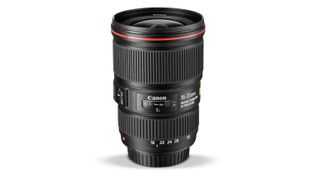Digital Camera World Verdict
It’s not the brightest or sharpest lens you could buy, but the Canon EF 16-35mm f/4L IS USM represents a superb balance of value and functionality. Providing a useful zoom range that’s especially good for landscapes, the EF 16-35mm f/4L IS USM bolsters these credentials with extensive weather sealing and a lightweight construction. It handles excellently, and its optical quality is bolstered by UD (Ultra-low Dispersion) elements and coatings designed for protection and enhanced light transmission. Provided you don’t specialise in low-light shooting and therefore require a wider maximum aperture, this is a superb buy for any landscape or cityscape photographer who will make the most of its wide zoom range.
Pros
- +
Robust, weather-sealed build
- +
Lightweight and portable
Cons
- -
Maximum aperture only f/4
- -
Sharpness fall-off at edges
Why you can trust Digital Camera World
One thing that’s really special about the Canon EF 16-35mm f/4L IS USM is the value it represents.
If you’re a photographer who’s generally working to a tight budget, you may have assumed that Canon’s premium L-series lenses, which are generally agreed to be among the best Canon lenses around, would always be out of your reach. Indeed, many of these pro-spec optics can and do come sporting price tags running into the multi-thousands. The Canon EF 16-35mm f/4L IS USM, however, can be picked up for much less. So, if you're a user of Canon DSLR cameras, is this still a premium lens that’s worthy of your time?
This Canon lens has a lot going for it. It’s worth comparing it to the range-topping EF 16-35mm f/2.8L III USM, a more expensive and high-end version, with a maximum aperture of f/2.8. However, the f/4 lens isn’t just an inferior version of the same zoom range – it is also more compact and lightweight, and for many, that combination of advantages will outweigh the extra f/stop in aperture rating of the f/2.8 lens, especially as the f/4 only costs about half as much to buy.

This lens is built to a pro-grade standard. As such, it’s robust and weather-sealed, with excellent handling. Optical highlights include two UD (Ultra-low Dispersion) elements and Super Spectra coating. Fluorine coatings are also applied to the front and rear elements.
As it’s a full-frame lens, the 108-degree viewing angle of the EF 16-35mm f/4L IS is comparable to using a zoom lens starting at 10mm on an APS-C camera. However, an upside to the Canon EF 16-35mm f/4L IS USM is that its tele end stretches further than many of these competing lenses, so it’s a good choice if you’d prefer not to swap the optic on the front of your camera too often.
Performance
We put the Canon EF 16-35mm f/4L IS USM through a series of rigorous optical tests. Our results found that it produces superb centre-sharpness, but drops off towards the edges and corners of the frame. Colour fringing is controlled well, and there’s little barrel and pincushion distortion at the short and long ends of the zoom range respectively.
The focus ring of the EF 16-35mm f/4L IS USM is nice and wide, and in use it has a smooth and fluid feel to its operation. The lens also features an image stabiliser, which helps keep handheld shots smooth and blur-free. It comes with a filter attachment thread – not always guaranteed on a full-frame lens – and comes supplied with a hood in the box for keeping out stray light. A full set of weather seals and fluorine coatings on the front and rear elements also make the EF 16-35mm f/4L IS USM well-suited for outdoor use even in poor weather – this pairs well with its lightweight build to make it an ideal lens for intrepid landscape photographers.
Read more:
Matthew Richards is a photographer and journalist who has spent years using and reviewing all manner of photo gear. He is Digital Camera World's principal lens reviewer – and has tested more primes and zooms than most people have had hot dinners!
His expertise with equipment doesn’t end there, though. He is also an encyclopedia when it comes to all manner of cameras, camera holsters and bags, flashguns, tripods and heads, printers, papers and inks, and just about anything imaging-related.
In an earlier life he was a broadcast engineer at the BBC, as well as a former editor of PC Guide.

